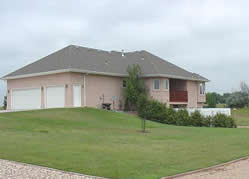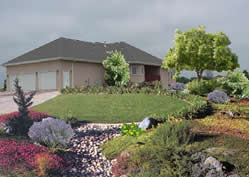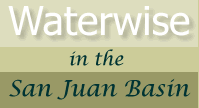Principle #3
Limit Lawn Size or Use an Alternative
The
typical landscape in our region is dominated by the
lawn. A lawn has its place in a xeric design as long
as it is limited in size and is used to meet a particular
function. Kentucky bluegrass is unequaled in its wearability,
making it the grass of choice when it comes to high
use areas, such as play spaces for children or pets.
For many homes, providing some lawn space is entirely
desirable and appropriate. A lawn need not be large,
however, to be useful and attractive. The trick is to
provide only enough lawn space to perform the needed
function. Furthermore, a smaller, shapely lawn can be
far more attractive than a large, homogenous bluegrass
landscape.
To achieve the optimum water conservation, bluegrass
turf should be planted separate from other plantings
so that it may be watered according to its own special
needs. A zone of moderate water use plants surrounding
the bluegrass turf area will make a good transition
from high water use area to a low water use area. Moderate
water use plants will benefit from any overspray from
the lawn. Additionally, root systems will grow toward
the turf zone and benefit from the higher soil moisture
content.
Try an Alternative Grass
If wearability is not a large concern, there are a number
of turf grass alternatives to a pure stand of Kentucky
bluegrass that are equally attractive and far less thirsty.
Many local seed suppliers specialize in creating blends
of grasses that contain bluegrass, but balance the mix
out with more drought-tolerant grasses such as brome,
fescues, and rye grasses.
 |
The
large Buffalo Grass lawn surrounding this home
is a good example of a water-thrifty, "alternative"
lawn planting. |
Lawns established with these mixes handle traffic well
and look nearly identical to bluegrass but can produce
a water savings of 20% to 50%.
Other grasses can save even more water. Buffalo grass,
for example, is a native grass that can survive on as
little as 5” or less of supplemental water per
year, compared to bluegrass which needs as much as 25”
of supplemental water per year. Buffalo grass is a warm-season
grass that turns brown with the first frost of fall.
It is a relatively short-growing grass reaching a height
of around four inches, making it a desirable grass for
those who desire a low-maintenance yard but still enjoy
the colorful characteristics of having a lawn.
Turf Grass Strategy
 |
| This
simulation illustrates another water-thrifty lawn
alternative that could have been constructed at
the same yard. In this case, a smaller Bluegrass
lawn is used as a lush welcome mat for the front
door and is surrounded by a variety of colorful,
drought-tolerant tress, shrubs and perennials. |
Avoid planting turf grass up to the foundation of a
building. There is no need to water a foundation. Accurate
watering of turf grass against a foundation can be difficult.
Overspray can cause water damage to sidings, and water
can cause damage to foundations. Instead, plant a minimum
of a four foot wide bed for perennials and shrubs. Perennials
and shrubs may be watered with drip irrigation, which
is far more efficient and does not tend to wet more
soil than is needed by the plants. Furthermore, perennials
and shrubs can be used to soften the hard architectural
lines and accentuate the architectural features through
colors and textures.
|

